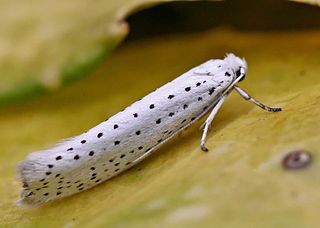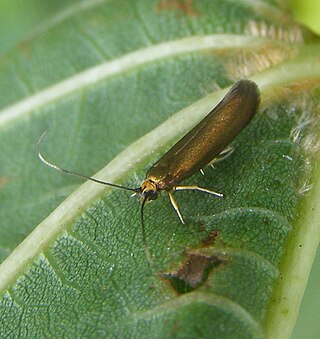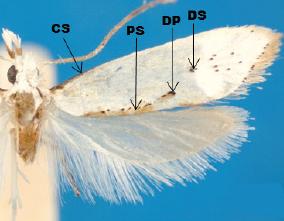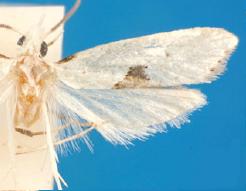
The family Yponomeutidae are known as the ermine moths, with several hundred species, most of them in the tropics. The larvae tend to form communal webs, and some are minor pests in agriculture, forestry, and horticulture. Adult moths are minor pollinators.

Pellegrinisaurus is a genus of titanosaurian sauropod dinosaur that lived in South America during the Late Cretaceous period. The holotype was found in the Allen Formation, Argentina.

The Lacturidae comprise a family of moths in the superfamily Zygaenoidea. Brightly coloured tropical moths, the Lacturidae have been previously placed in the Plutellidae, Yponomeutidae, and Hyponomeutidae.

Roeslerstammiidae is a family of insects in the order Lepidoptera. The family arose from the taxonomic uncertainty of the genus Roeslerstammia Zeller, 1839, which was assigned to different families. The genus Roeslerstammia was removed from the Yponomeutidae Stephens, 1829, and placed in the Amphitheridae Meyrick, 1913, which in consequence became a junior synonym of Roeslerstammiidae. Consequently, Roeslerstammiidae comprises the Palearctic genus Roeslerstammia, as well as the Oriental and Australasian genera that form part of the Amphitheridae.

The golden grouper, also known as the pink grouper or Powell's grouper, is a species of marine ray-finned fish, a grouper from the subfamily Epinephelinae which is part of the family Serranidae, which also includes the anthias and sea basses. It is found in the eastern Indian Ocean and Western Pacific Ocean.

Eucalantica is a genus of moths of the family Yponomeutidae. Species in the genus are superficially similar to Thecobathra species, which also have a silvery white body and forewings, but differ from the latter in having a dark brown costal streak in forewing.

Kessleria is a genus of moths of the family Yponomeutidae.
Saridoscelinae is a subfamily of moths of the family Yponomeutidae.

Eucalantica polita is a moth in the family Yponomeutidae. It is found at the Pacific side of the coastal regions of Canada and the United States.

Eucalantica costaricae is a moth in the family Yponomeutidae. It is found in Costa Rica.

Eucalantica ehecatlella is a moth in the family Yponomeutidae. It is found in Costa Rica.

Eucalantica icarusella is a moth in the family Yponomeutidae. It is found in Costa Rica.

Eucalantica pumila is a moth in the family Yponomeutidae. It is found in Costa Rica.

Eucalantica vaquero is a moth in the family Yponomeutidae. It is found in the United States and Mexico.
Greya powelli is a moth of the family Prodoxidae. It is found in the coastal range between the San Francisco Bay area and the San Gabriel Mountains, and in the south-central Sierra Nevada of California. The habitat consists of slightly moist grassy areas in open oak woodland.

Brachodes is a genus of moths in the family Brachodidae.
Henricus powelli is a species of moth of the family Tortricidae. It is found in Mexico in the states of Tamaulipas, Nuevo León and Veracruz.
Clepsis powelli is a species of moth of the family Tortricidae. It is found in Veracruz, Mexico.
Tinagma powelli is a moth in the Douglasiidae family. It is found in North America, where it has been recorded in California.
Notonychops is an extinct genus of mammal, belonging to the order Litopterna, that lived during the Middle to Late Paleocene in what is today South America.







